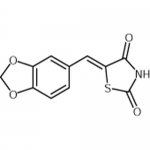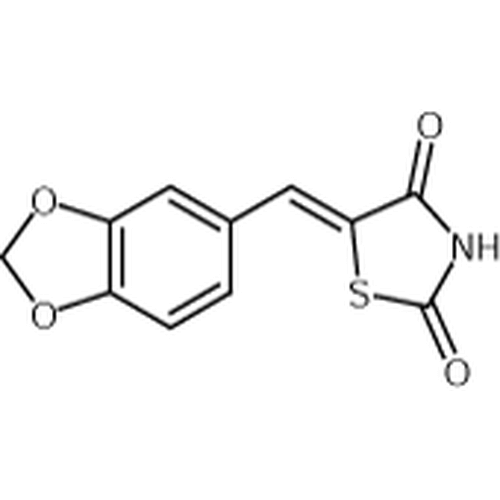| Product Name | AS 041164 |
| Description |
PI 3-Kgamma kinase inhibitor |
| Purity | >98% (TLC) |
| CAS No. | 6318-41-8 |
| Molecular Formula | C11H7NO4S |
| Molecular Weight | 249.2 |
| Field of Use | Not for use in humans. Not for use in diagnostics or therapeutics. For in vitro research use only. |
Properties
| Storage Temperature | -20ºC |
| Shipping Temperature | Shipped Ambient |
| Product Type | Inhibitor |
| Solubility | Soluble in DMSO (25 mg/ml). For in vivo administration this compound was suspended in 0.5% carboxymethylcellulose/0.25% Tween 20 as a vehicle |
| Source | Synthetic |
| Appearance | Yellow solid |
| SMILES | C2=C(C=C1/C(NC(S1)=O)=O)C=CC3=C2OCO3 |
| InChI | InChI=1S/C11H7NO4S/c13-10-9(17-11(14)12-10)4-6-1-2-7-8(3-6)16-5-15-7/h1-4H,5H2,(H,12,13,14) |
| InChIKey | SDGWAUUPHUBJNQ-UHFFFAOYSA-N |
| Safety Phrases |
Classification: Not a hazardous substance or mixture. Safety Phrases: S22 - Do not breathe dust. S24/25 - Avoid contact with skin and eyes. S36/37/39 - Wear suitable protective clothing, gloves and eye/face protection. |
| Cite This Product | AS 041164 (StressMarq Biosciences Inc., Victoria BC CANADA, Catalog # SIH-433) |
Biological Description
| Alternative Names | NSC31098, 5-Benzo[1,3]dioxol-5-ylmethylene-thiazolidine-2,4-dione |
| Research Areas | Apoptosis, Cancer, Cancer Growth Inhibitors, Cell Signaling, Tyrosine Kinase Inhibitors |
| PubChem ID | 233033 |
| Scientific Background | AS 041164 is a selective inhibitor of the PI3Kγ isoform, a key regulator of immune cell signaling and migration. In neuroscience, PI3Kγ has been implicated in neuroinflammatory responses and microglial activation, processes that contribute to the progression of neurodegenerative diseases. By blocking PI3Kγ activity, AS 041164 can modulate leukocyte trafficking and reduce neuroinflammation, making it a valuable tool for studying immune-mediated mechanisms in conditions such as multiple sclerosis, Alzheimer’s disease, and Parkinson’s disease. Its ability to inhibit neutrophil migration further supports its application in models of neurovascular inflammation and blood-brain barrier dysfunction. |
| References | 1. Ferrandi C., et al. (2007) J. Pharmacol. Exp.Ther. 322(3): 923–930. |



Reviews
There are no reviews yet.